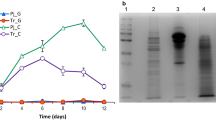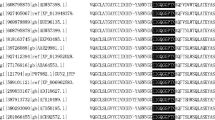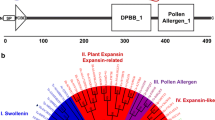Abstract
Filamentous fungi produce a variety of proteases with significant biotechnological potential and show diverse substrate specificities. Proteolytic analysis of the industrial enzyme producer Trichoderma reesei has been sparse. Therefore, we determined the substrate specificity of T. reesei secretome and its main protease Trichodermapepsin (TrAsP) up to P1 position using FRETS-25Xaa-libraries. The role of TrAsP was analyzed using T. reesei QM9414 and the deletant QM∆trasp in Avicel. We observed higher activities of CMCase, Avicelase, and Xylanase in QM∆trasp compared to that of QM9414. Saccharification rate of cellulosic biomass also increased when using secretome of QM∆trasp but the effect was not significant due to the absence of difference in BGL activity compared to QM9414. Higher TrAsP was produced when monosaccharides were used as a carbon source compared to cellulase inducers such as Avicel and α-sophorose. These results elucidate the relationship between TrAsP and cellulase production in T. reesei and suggest a physiological role for TrAsP.







Similar content being viewed by others
References
Ahmed ME (2018) Extraction and purification of protease from Aspergillus niger isolation. Pharm Pharmacol Int J 6:96–99. https://doi.org/10.15406/ppij.2018.06.00162
Amore A, Giacobbe S, Faraco V (2013) Regulation of cellulase and hemicellulase gene expression in fungi. Curr Genom 14:230–249. https://doi.org/10.2174/1389202911314040002
Braaksma M, Smilde AK, van der Werf MJ, Punt PJ (2009) The effect of environmental conditions on extracellular protease activity in controlled fermentations of Aspergillus niger. Microbiology 155:3430–3439. https://doi.org/10.1099/mic.0.031062-0
de Castro RJS, Sato HH (2014) Protease from Aspergillus oryzae: biochemical characterization and application as a potential biocatalyst for production of protein hydrolysates with antioxidant activities. J Food Process 2014:1–11. https://doi.org/10.1155/2014/372352
Delgado-Jarana J, Rincón AM, Benítez T (2002) Aspartyl protease from Trichoderma harzianum CECT 2413: cloning and characterization. Microbiology 148:1305–1315. https://doi.org/10.1099/00221287-148-5-1305
Eneyskaya EV, Kulminskaya AA, Shabalin KA et al (1999) Acid protease from Trichoderma reesei: limited proteolysis of fungal carbohydrases. Appl Microbiol Biotechnol 52:226–231. https://doi.org/10.1007/s002530051513
Gente S, Billon-Grand G, Poussereau N, Févre M (2001) Ambient alkaline pH prevents maturation but not synthesis of ASPA, the aspartyl protease from Penicillium roqueforti. Curr Genet 38:323–328
Haab D, Hagspiel K, Szakmary K, Kubicek CP (1990) Formation of the extracellular proteases from Trichoderma reesei QM 9414 involved in cellulase degradation. J Biotechnol 16:187–198. https://doi.org/10.1016/0168-1656(90)90035-A
Hagspiel K, Haab D, Kubicek C (1989) Protease activity and proteolytic modification of cellulases from a Trichoderma reesei QM 9414 selectant. Appl Microbiol Biotechnol 32:61–67. https://doi.org/10.1007/BF00164824
Hamin Neto YAA, da Rosa Garzon NG, Pedezzi R, Cabral H (2017) Specificity of peptidases secreted by filamentous fungi. Bioengineered 5979:1–8. https://doi.org/10.1080/21655979.2017.1373531
Van Den Hombergh JPTW, Van De Vondervoort PJI, Fraissinet-Tachet L, Visser J (1997) Aspergillus as a host for heterologous protein production: the problem of proteases. Trends Biotechnol 15:256–263. https://doi.org/10.1016/S0167-7799(97)01020-2
Kamitori S, Ohtaki A, Ino H, Takeuchi M (2003) Crystal structures of Aspergillus oryzae aspartic proteinase and its complex with an inhibitor pepstatin at 1.9 Å resolution. J Mol Biol 326:1503–1511. https://doi.org/10.1016/S0022-2836(03)00078-0
Karaffa L, Fekete E, Gamauf C et al (2006) D-Galactose induces cellulase gene expression in Hypocrea jecorina at low growth rates. Microbiology 152:1507–1514. https://doi.org/10.1099/mic.0.28719-0
Kawai T, Nakazawa H, Ida N et al (2012) Analysis of the saccharification capability of high-functional cellulase JN11 for various pretreated biomasses through a comparison with commercially available counterparts. J Ind Microbiol Biotechnol 39:1741–1749. https://doi.org/10.1007/s10295-012-1195-9
Kawamori M, Morikawa Y, Shinsha Y et al (1985) Preparation of mutants resistant to catabolite repression of Trichoderma reesei. Agric Biol Chem 49:2875–2879. https://doi.org/10.1080/00021369.1985.10867203
Kubicek-Pranz EM, Gsur A, Hayn M, Kubicek CP (1991) Characterization of commercial Trichoderma reesei cellulase preparations by denaturing electrophoresis (SDS-PAGE) and immunostaining using monoclonal antibodies. Biotechnol Appl Biochem 14:317–323
Landowski CP, Huuskonen A, Wahl R et al (2015) Enabling low cost biopharmaceuticals: a systematic approach to delete proteases from a well-known protein production host Trichoderma reesei. PLoS One 10:1–28. https://doi.org/10.1371/journal.pone.0134723
Li Q, Yi L, Marek P, Iverson BL (2013) Commercial proteases: present and future. FEBS Lett 587:1155–1163. https://doi.org/10.1016/j.febslet.2012.12.019
Mach-Aigner AR, Pucher ME, Steiger MG et al (2008) Transcriptional regulation of xyr1, encoding the main regulator of the xylanolytic and cellulolytic enzyme system in Hypocrea jecorina. Appl Env Microbiol 74:6554–6562. https://doi.org/10.1128/AEM.01143-08
Mandels M, Reese ET (1957) Induction of cellulase in Trichoderma viride as influenced by carbon sources and metals. J Bacteriol 73:269–278. https://doi.org/10.1002/path.1700730133
Mandels M, Parrish FW, Reese ET (1962) Sophorose as an inducer of cellulase in Trichoderma viride. J Bacteriol 83:400–408
Mäntylä M, Paloheimo MSP (1998) Industrial mutants and recombinant strains of Trichoderma reesei. In: Christian P, Harman GE, Ondik KL, Kubicek CP (eds) Trichoderma and Gliocladium. Taylor and Francis, London, pp 291–309
Margolles-Clark E, Hayes CK, Harman GE, Penttilä M (1996) Improved production of Trichoderma harzianum endochitinase by expression in Trichoderma reesei. Appl Env Microbiol 62:2145–2151
Mojzita D, Herold S, Metz B et al (2012) l- xylo -3-Hexulose reductase is the missing link in the oxidoreductive pathway for d-galactose catabolism in filamentous fungi. J Biol Chem 287:26010–26018. https://doi.org/10.1074/jbc.M112.372755
Moralejo FJ, Cardoza RE, Gutierrez S et al (2002) Silencing of the aspergillopepsin B (pepB) gene of Aspergillus awamori by antisense RNA expression or protease removal by gene disruption results in a large increase in thaumatin production. Appl Environ Microbiol 68:3550–3559. https://doi.org/10.1128/AEM.68.7.3550-3559.2002
Moreno-Mateos MA, Delgado-Jarana J, Codón AC, Benítez T (2007) pH and Pac1 control development and antifungal activity in Trichoderma harzianum. Fungal Genet Biol 44:1355–1367. https://doi.org/10.1016/j.fgb.2007.07.012
Muthukrishnan S, Mukilarasi K (2016) Industrial important protease screening and optimization from micro-fungal isolates of Ayyanar Falls Forest Samples, Rajapalalyam. World Appl Sci J 34:343–347. https://doi.org/10.5829/idosi.wasj.2016.34.3.23113
Nascimento AS, Krauchenco S, Golubev AM et al (2008) Statistical coupling analysis of aspartic proteinases based on crystal structures of the Trichoderma reesei enzyme and its complex with pepstatin A. J Mol Biol 382:763–778. https://doi.org/10.1016/j.jmb.2008.07.043
Nevalainen KMH, Te’o VSJ, Bergquist PL (2005) Heterologous protein expression in filamentous fungi. Trends Biotechnol 23:468–474. https://doi.org/10.1016/j.tibtech.2005.06.002
Peciulyte A, Anasontzis GE, Karlström K et al (2014) Morphology and enzyme production of Trichoderma reesei Rut C-30 are affected by the physical and structural characteristics of cellulosic substrates. Fungal Genet Biol 72:64–72. https://doi.org/10.1016/j.fgb.2014.07.011
Pitts JE, Crawford MD, Nugent PG et al (1995) The three-dimensional X-ray crystal structure of the aspartic proteinase native to Trichoderma reesei complexed with a renin inhibitor CP-80794. Springer, Boston, pp 543–547
Rao MB, Tanksale AM, Ghatge MS, Deshpande VV (1998) Molecular and biotechnological aspects of microbial proteases. Microbiol Mol Biol Rev 62:597–635
Rauscher R, Wurleitner E, Wacenovsky C et al (2006) Transcriptional regulation of xyn1, encoding xylanase I, in Hypocrea jecorina. Eukaryot Cell 5:447–456. https://doi.org/10.1128/EC.5.3.447-456.2006
Siala R, Sellami-Kamoun A, Hajji M et al (2009) Extracellular acid protease from Aspergillus niger I1: purification and characterization. Afr J Biotechnol 8:4582–4589. https://doi.org/10.5897/AJB09.063
da Silva RR, de Oliveira LCG, Juliano MA et al (2017) Biochemical and milk-clotting properties and mapping of catalytic subsites of an extracellular aspartic peptidase from basidiomycete fungus Phanerochaete chrysosporium. Food Chem 225:45–54. https://doi.org/10.1016/j.foodchem.2017.01.009
da Silva RR, Souto TB, de Oliveira TB et al (2016) Evaluation of the catalytic specificity, biochemical properties, and milk clotting abilities of an aspartic peptidase from Rhizomucor miehei. J Ind Microbiol Biotechnol 43:1059–1069. https://doi.org/10.1007/s10295-016-1780-4
de Souza PM, de Assis Bittencourt ML, Caprara CC et al (2015) A biotechnology perspective of fungal proteases. Braz J Microbiol 46:337–346. https://doi.org/10.1590/S1517-838246220140359
Sternberg D, Mandels GR (1979) Induction of cellulolytic enzymes in Trichoderma reesei by sophorose. J Bacteriol 139:761–769
Tanskul S, Oda K, Oyama H et al (2003) Substrate specificity of alkaline serine proteinase isolated from photosynthetic bacterium, Rubrivivax gelatinosus KDDS1. Biochem Biophys Res Commun 309:547–551
Yu L-X, Gray BN, Rutzke CJ et al (2007) Expression of thermostable microbial cellulases in the chloroplasts of nicotine-free tobacco. J Biotechnol 131:362–369. https://doi.org/10.1016/J.JBIOTEC.2007.07.942
Acknowledgements
This work was partially supported by a grant from the New Energy and Industrial Technology Development Organization (NEDO) Project (P16009). Furthermore, our sincere thanks go to Nobuyuki Homma; Nagaoka University of Technology, for contributing the substrate specificity and kinetic analysis.
Author information
Authors and Affiliations
Corresponding author
Ethics declarations
Conflicts of interest
The authors declare that there are no conflicts of interest.
Additional information
Publisher's Note
Springer Nature remains neutral with regard to jurisdictional claims in published maps and institutional affiliations.
Electronic supplementary material
Below is the link to the electronic supplementary material.
Rights and permissions
About this article
Cite this article
Daranagama, N.D., Shioya, K., Yuki, M. et al. Proteolytic analysis of Trichoderma reesei in celluase-inducing condition reveals a role for trichodermapepsin (TrAsP) in cellulase production. J Ind Microbiol Biotechnol 46, 831–842 (2019). https://doi.org/10.1007/s10295-019-02155-9
Received:
Accepted:
Published:
Issue Date:
DOI: https://doi.org/10.1007/s10295-019-02155-9




